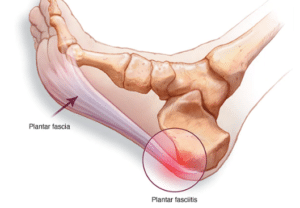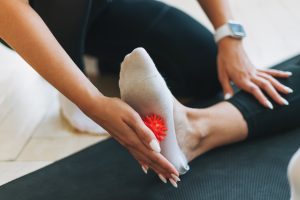
Latest on plantar fasciitis
Want to know more about the latest on plantar fasciitis?
The aim of this blog is to provide you an insight into plantar fasciitis, as well as effective treatment strategies.
What is the plantar fascia? And what is its role and function?
The plantar fascia is a dense, fibrous connective tissue attached to the heels, toes and many of the surrounding muscles and structures on the sole of the foot. It is liken to an analogy of a bow-tie, connecting the heel region to all five toes.

The tough and fibrous nature of the plantar fascia makes it a strong support for the arches of the foot. In addition, the plantar fascia also aids in transmitting forces during weight bearing tasks.
When we push-off our toes during walking or running to propel us forwards, the tensile strain on the plantar fascia has found to increase up to 1.8 and 3.7 times body weight, respectively.
This will be an important consideration in the treatment of plantar fasciitis.
Who gets plantar fasciitis? Are there predisposing factors?

Plantar fasciitis is a condition that is seen across different age populations. This condition affects approximately 10% of individuals in their lifetime. On one end of the spectrum, we may see a runner who has undergone sudden or gradual increase in running volume. On the other end, we may have an older and more sedentary individual with a higher body mass index (BMI).
What are the symptoms of plantar fasciitis?
The symptoms and characteristics of plantar fasciitis are often fairly recognizable. These main symptoms include:
- Heel pain with first steps in the morning upon waking
- Standing or walking after any prolonged period of rest
- Pain may be worse when barefoot on hard surfaces and with stair climbing.
- Sudden or gradual increase in weight bearing loads prior to onset of symptoms
Common misunderstanding of plantar fasciitis
-
Plantar fasciitis is an inflammatory condition:
Inflammation was previously believed to be the cause of plantar fasciitis pain. However, research has revealed evidence of degeneration and thickening associated with plantar fasciitis, as opposed to acute inflammation. In addition, there also appears to be a relationship between mechanical load and the etiology and symptomology. Therefore, one of the treatment strategies will be aimed at altering mechanical load on the plantar fascia.
This is not to say that we can completely discount the role of inflammation in plantar fasciitis. Inflammation is just likely isn’t the primary driver or main focus of our treatment.
-
We can break up scar tissues and adhesions in the plantar fascia
The plantar fascia is VERY strong and dense in its structure, that research has found that it takes over 1,800 pounds to compress it by just 1%. Why does this matter?
This is because many treatments proposed for plantar fasciitis are aimed at breaking up scar tissues or adhesions located within the plantar fascia. It seems almost impossible that we can alter the composition of the thick and dense plantar fascia via any foam roller or manual therapy technique.
Of course, these can still be useful tools in assisting with pain relief, which will then provide us a window of opportunity to move around, exercise and carry out our daily tasks.

What are some treatment strategies for plantar fasciitis?
The following are a few non-surgical treatment options for plantar fasciitis:
-
Load management
Something as simple as making changes in your daily routine can be effective. This allows you to continue with meaningful activities that you enjoy.
If you are a runner for instance, you can manipulate parameters such as frequency, distance or intensity of your run. In addition, cross-training can also be a valuable tool to maintain fitness levels while minimizing aggravating symptoms.
You must be wondering… should you push through pain while exercising? A good guideline you can use is to keep pain tolerable. What is tolerable is obviously very unique to each individual. What we want to aim for is tolerable pain levels during activity, and pain that does not worsen later in the day or the next day.
-
Exercises for the plantar fascia
- Stretches: provide effective temporary symptomatic relief.
- Selected exercises that purposefully strain the plantar fascia: induce resilience of the plantar fascia over time and help to improve its load capacity.
- Important to also strengthen the rest of the leg and trunk muscles, as the body works as a whole system.

You can also check out our YouTube for some lower body exercises.
-
Shoe wear
Some shoe wear options that may help reduce your symptoms include:
- Good heel section with a slight raise
- Fairly firm toe section that resists excess bend.
At the end of the day, comfort is key. Find what suits your feet and what it needs. Try out several shoes, see which seem to help your symptoms and feel comfortable.
-
Foot Orthoses
Most research found that foot orthoses only provide medium-term benefits (7-12 weeks) in relation to pain reduction. Therefore, foot orthoses may be used for temporary role in symptom modification, rather than long-term management.
We hope that you have gained some valuable information on plantar fasciitis.
If you struggle with plantar fasciitis or suspect that you may have plantar fasciitis, book an appointment with an experienced physiotherapist at Pivotal Motion Physiotherapy. Call on 07 3352 5116 or book online today.





